Bekopaka
Wednesday, July 23, 2014
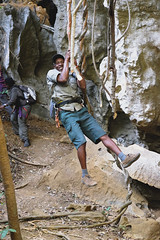
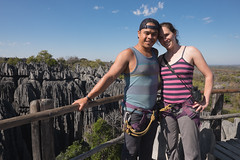
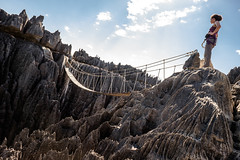
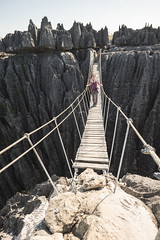
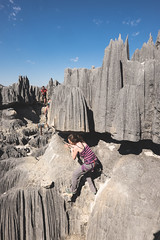
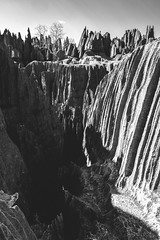
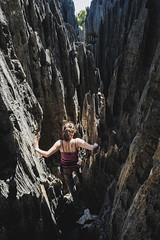
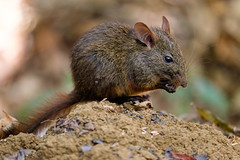
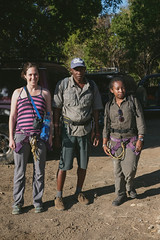
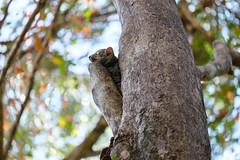
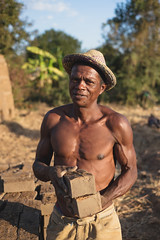

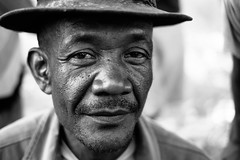
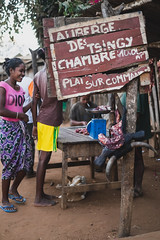
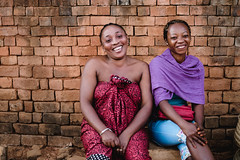
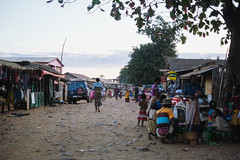
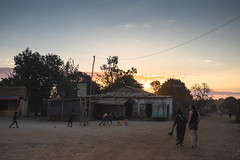
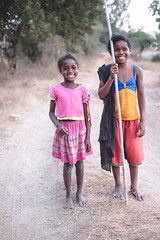
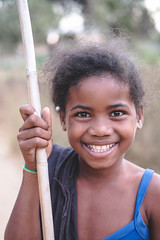
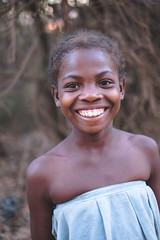
We woke up early to do the one hour / 15 km drive up the terrible road to the “big tsingy” area. We had Ranovelo in the car so three in the back which made for extra bumpy fun.
The hike took four hours and was a good time. We had to wear climbing equipment as we had to hook into different railing systems that kept us safe as we climbed among the steep walls. The trail was beautifully constructed and laid out – they had nailed stones to the stone walls as steps so they blended in more, and just a few small bridges.
It was more of the same as yesterday – interesting rock patterns and trees woven through. There was some visible fossils on some of the walls. I tried chewing some guava leaves – they are a pain medication.
There are a lot of tourists on this trail from all over and the guides know all sorts of languages. At one of the viewpoints their was Malagasy, Italian, English and French all being spoken at once. We’ve made acquaintances with two Italian women from our hotel. I love how Italian sounds! One of the ladies always travels in Madagascar – she loves it. And she loves Bruce Springsteen and especially wore his shirt so she could show us!
We saw another species of coua called the Giant Coua. Ranovelo came through as a guide more today – Christian was making him laugh a bit and he was showing him good photo spots. He also was good at spotting sleeping lemurs. Aw sleeping animals! We saw a sleeping Red tailed sportive lemur and a sleeping western sportive lemur, both normally nocturnal.
On the way back we gave a young man named Daniel a ride in the back of the car. His job is fixing the trail in the park.
After some lunch and a bit of relaxing, Christian had the idea to take a small walk with Claudia through Bekopaka. I braced myself for being the center of attention but it was quite nice. Many people were very friendly and welcoming although there are always those that are not – they work so hard here I can’t imagine how it is to have soft leisurely tourists strolling through your streets. Christian is very good at talking to folks and asking them quite sincerely if they would like their picture taken. Not everyone agrees but some do and they always laugh when they look at the result in the back of the camera.
The first people we ran into were brickmakers including the friendly Rokoto who got his Christian portrait taken. Claudia explained to me the process of digging up the mud on site, forming it and drying it in the sun before firing it with wood. The men camp out on the site. We laughed at one that had a dog print in it.
There were a couple of young boys with a homemade wooden gun as a toy. They were interested but had been scared by their parents that vazaha take little kids and they should stay away from us.
Next was Tilda and her younger sister Jeanne who were pounding rice into flour using a big pole outside their house. I have it a shot but don’t have the technique quite right.
Then we got to the main market. We were checking out the raw tobacco being sold and Christian asked the tobacco sellers if anyone wanted their photo taken. Tampoina, an older man, agreed. As this was happening another man came up and started talking loudly to Christian in French – thinking most vazaha speak French which we don’t. Christian kept saying English and the man kept saying oh I don’t know English and kept trying to get his point across in French. It was funny and we had gathered quite a crowd. Basically he was saying that we should send Tampoina a copy of his photo. We agreed and got the address.
We passed a butcher who had a whole zebu head with flies buzzing all around hanging up – yuck! Claudia was interested in a liter of pure honey for the low price of 8000 ariary – 15000 in Tana. This is basically a quart of honey selling for 4 dollars! Each town also has a “movie house” where you can pay the equivalent of 5 cents to see some sort of action movie in a dark shack. We also saw some boys playing with a homemade ball – found old plastic bags tied up with string. Worked quite well and we did a bit of hackysack.
On the way back we ran into two groups of girls – one younger and one older. The older women had some tubs on their head which always impresses me. Both groups posed for photos.
The population here is very young. Life expectancy is 63 years old and 44% of the population is under 14. The average birthdate in the countryside is 7 children and you definitely notice piles and piles of kids everywhere you go. I asked Claudia about the birthdate and she said that people in the country, subsistence farmers, depend on their kids for retirement since they don’t have money for retirement. The kids take care of them when they are older.
I also found out that the hotel cooks all our delicious meals over a fire. Claudia cooks over charcoal in her city too. From this, I am assuming almost no one uses gas or electric stoves in Madagascar! This adds a whole new complication to cooking – not only watching the pot but watching the fire too!